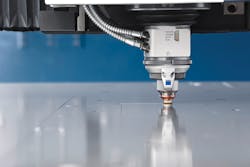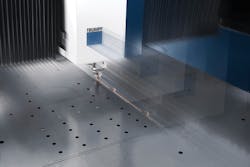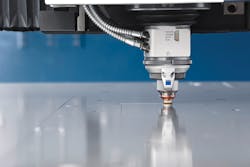High-speed nozzles increase productivity while reducing gas consumption
NICK STANCZYC
One of the most critical aspects for a fabricator’s fabrication process is obtaining good cut quality on parts. Custom Laser (Lockport, NY) says this would not be possible without customers that trust in its ability to provide cutting-edge solutions for complex ideas with dedicated employees that make it happen. This company has been forward-looking since 1986, when it was founded in Lockport as Custom Laser Engraving in a 300-sq-ft. garage with one laser system, and it has continued to advance its capabilities to remain best-in-class.
The company built an 8000-sq-ft. facility in 1997, doubling it to 16,000 sq. ft. in 2001. In 2006, it added its first flying-head design laser to help handle the increased workload and provide better delivery to its ever-growing customer base. It again increased its cutting capability with the addition of another 4000 W laser, and it purchased its first laser tube cutter in 2011 and expanded into a third facility, enlarging fabrication space to 56,000 sq. ft. The company now has 12 laser cutting systems, including a Trumpf tube cutter installed in 2014 and an 8 kW fiber laser-powered sheet metal cutter installed in 2015.
The ability to do this while reducing the cost of gas consumption and increasing cutting speeds without hindering the integrity or quality of components sounded ideal to Custom Laser, which specializes in component part manufacturing. The company learned about the benefits of Trumpf’s Highspeed Eco Nozzle and opted to give the technology a try.
Nitrogen advantages
It is no secret that using nitrogen assist gas presents several advantages in the laser cutting process when compared to the use of oxygen assist gas. Eliminating secondary operations prior to painting or final assembly are just two examples of instances where the use of nitrogen assist gas can save fabricators time and money. Trumpf’s nozzle technology focuses on this goal that Custom Laser was aiming to achieve—delivering significantly increased throughput with drastically reduced gas consumption for the laser cutting of sheet metal with nitrogen assist gas, resulting in decreased operating costs and increased productivity. About seven months ago, the company began utilizing the Highspeed Eco Nozzle on its 8 kW TruLaser 5030 fiber laser machine (FIGURE).
Custom Laser added the Highspeed Eco Nozzle (bottom) to its 8 kW TruLaser 5030 fiber laser machine.
Custom Laser was looking for a way to process thicker materials, especially mild steel, using nitrogen assist gas. Traditionally, an increase in material thickness has required an increase in laser power to achieve high-quality laser cutting results. However, with this Trumpf nozzle, the amount of nitrogen consumed has been reduced and the amount of time it was used has increased nitrogen-cutting capacity and reduced cost. The company has taken advantage of this technology on 7-gauge mild steel up to 0.5 in. and 7-gauge stainless steel up to 1 in.
“The technology is much faster and has better control of pierces in comparison to oxygen in carbon steel,” explains Cameron Lambert, a laser technician for Custom Laser. “It allows much faster cutting of thicker carbon and stainless steel—in some cases, 100+ IPM [inches per minute] faster.” Since the nozzle uses a touchdown technique—meaning the sleeve rides directly over the surface of the material—the company’s nitrogen gas consumption has been drastically reduced when compared to a standard cutting technique.
Cost reduction
To further minimize operational costs, the Highspeed Eco nozzle process has allowed Custom Laser to further minimize operational costs by making use of a bi-flow nozzle that comprises three pieces: the nozzle upper, the insert, and the sleeve. During the cutting process, some of the gas passes through the center of the nozzle, along with the laser beam—the principal flow. The remainder of the gas forms a secondary flow around the principal flow to concentrate it into the kerf to help expel molten material more efficiently.
When using a standard nozzle, a lot of the assist gas is lost unnecessarily because of the distance of the nozzle in relation to the material being cut. During the standard fusion cutting process, higher pressures and flow rates are required to get enough gas to reach the kerf and expel the molten material, which contributes to the increase of lost gas. With the Highspeed Eco nozzle, the sleeve seals off the kerf and allows for the assist gas to be channeled directly into the kerf, ultimately minimizing the amount of gas that is lost.
As a result of this touchdown technique, Custom Laser has been able to save significantly on gas consumption. “The eco-nozzle is a great addition to our arsenal of laser equipment from Trumpf,” explains Gary Brockman, president and owner of Custom Laser. “It helps us maintain a competitive advantage through both cost savings in gas consumption and process time, along with quality of finished parts for our customers.”
Using the Highspeed Eco nozzles has enabled Custom Laser to use just one type of nozzle across the entire applicable material thickness range for mild and stainless steel of at least 0.16 in. This has made mix-ups less likely and shortens setup times, minimizing the chance for human error. Laser cutting with nitrogen using Highspeed Eco has shown consistent high-quality cutting edges across material that fits the range of material thicknesses acceptable for the company. Aside from cut edge quality, the company has increased its cutting speeds across applicable material by between 50% to 60%. In addition, part cleanup has also been reduced between 50 to 60%.
NICK STANCZYC ([email protected]) is sales engineer at Trumpf, Farmington, CT; www.trumpf.com/en_us.


